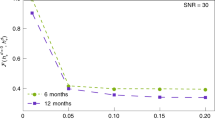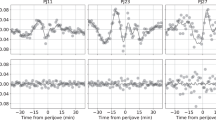Abstract
THIS communication concerns recent developments in the determination of the lunar gravity field from the accelerations experienced by the lunar Orbiters during their motion around the Moon. I shall refer to the papers by Muller and Sjogren1,2 which present, in the form of a map of equigravity contours, the final result of their reduction of the raw doppler data recorded during the actual motion. The adopted datum is the accelerations due to the second order gravity harmonic, so that in the contour map they give the surface gravity of the locus minus the local accelerations corresponding to the second harmonic.
This is a preview of subscription content, access via your institution
Access options
Subscribe to this journal
Receive 51 print issues and online access
$199.00 per year
only $3.90 per issue
Buy this article
- Purchase on Springer Link
- Instant access to full article PDF
Prices may be subject to local taxes which are calculated during checkout
Similar content being viewed by others
References
Muller, P. M., and Sjogren, W. L., Tech. Rep. 32–1072 (Jet Propulsion Laboratory, Pasadena, California, 1968).
Muller, R. M., and Sjogren, W. L., Science, 161, 680 (1968).
Urey, H. C., in Physics and Astronomy of the Moon (edit. by Kopal, Z.), 484 (Academic press, New York, 1968).
Bray, T. A., and Goudas, C. L., Icarus, 5, 526 (1966).
Aeronautical Chart and Information Center, Tech. Rep. No. 15, (US Air Force, St Louis, Missouri, 1965).
Author information
Authors and Affiliations
Rights and permissions
About this article
Cite this article
GOUDAS, C. Lunar “Mascons”. Nature 220, 1111–1112 (1968). https://doi.org/10.1038/2201111b0
Received:
Issue Date:
DOI: https://doi.org/10.1038/2201111b0
Comments
By submitting a comment you agree to abide by our Terms and Community Guidelines. If you find something abusive or that does not comply with our terms or guidelines please flag it as inappropriate.



